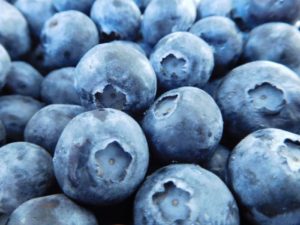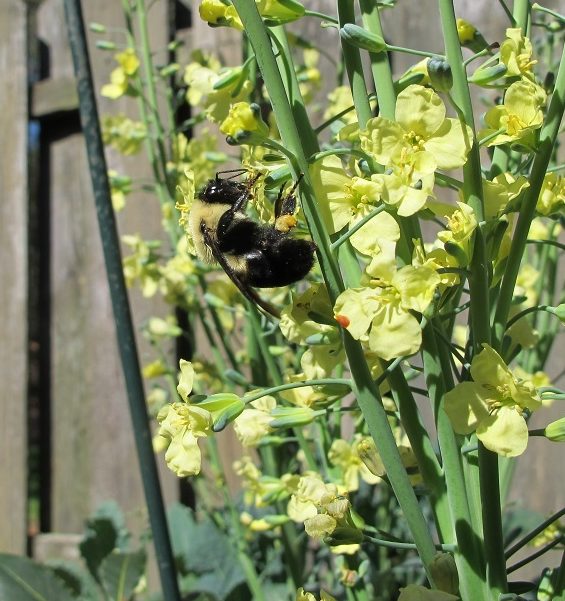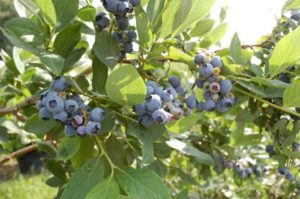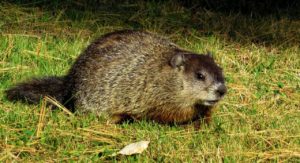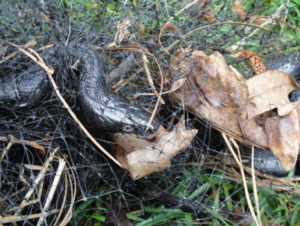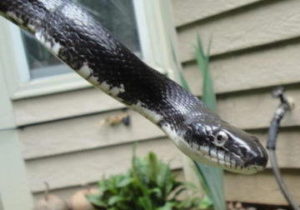Page 2
The 5 Major Groups of Blueberries
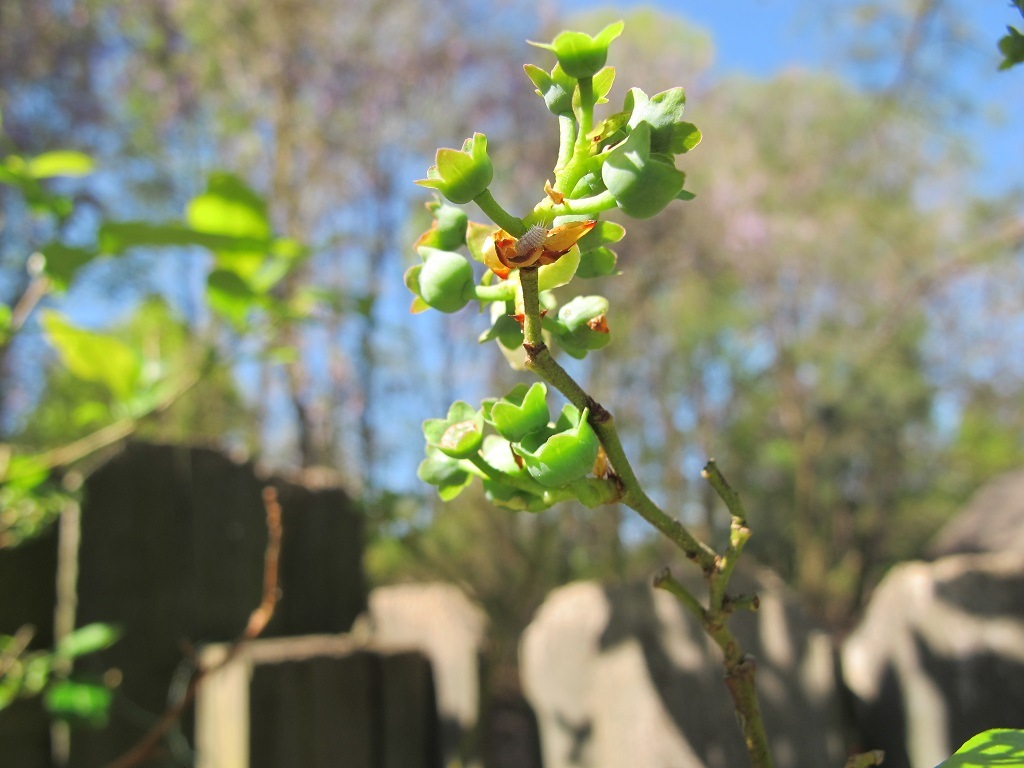
‘Patriot’ blueberry setting fruit (April 2, 2020).
1. Lowbush Blueberry
As the name indicates, lowbush blueberries (“wild”, or V. angustifolium) are short, growing only 1′ or 2′ tall, and have small berries. They require very little pruning but benefit from a hard pruning every 3 years.
‘Top Hat’ and ‘Ruby Carpet’ are in this group, and they grow in Zones 3-7. Lowbush blueberries are not self-fertile; they require cross-pollination from other lowbush or highbush cultivars for fruits to set.
2. Northern Highbush Blueberry
Varieties in this group grow 5′ to 12′ tall, and are native to eastern Canada and eastern and southern U.S. to Florida and Texas. It has naturalized in the Pacific Northwest, Europe, New Zealand, and Japan. V. corymbosum generally does not self-pollinate, although some varieties will.
This species is the one most commonly grown, and often displays beautiful fall color. Varieties include ‘Aurora’, ‘Bluecrop’, ‘Bluegold’, ‘Blueray’, ‘Darrow’, ‘Duke’, ‘Elliott’, ‘Hardyblue’, ‘Jersey’, ‘Kabluey’, ‘Northland’, ‘Patriot’ (this one has some lowbush parentage, and grows to about 5′ tall), ‘Rubel’, and ‘Spartan’.
This group requires a high number of chilling hours, 800 or more below 45 degrees, and grows better in colder climates (zones 3-7).
3. Southern Highbush Blueberry
Hybrids between V. corymbosum and the Florida native, V. darrowii, have lower chilling requirements, and can tolerate slightly drier soil as well as higher summer temperatures. These varieties are generally self-fertile, although cross-pollination yields earlier and larger berries.
Most grow 6′ to 9′ tall. Because they bloom in late winter, the flowers are susceptible to late frosts. Frosted flowers will not yield fruits.
Grow southern highbush varieties in areas with mild winters, or plan ahead if frost threatens. Some of the varieties are ‘Blue Ridge’, ‘Blue Suede’, ‘Cape Fear’, ‘Georgia Gem’, ‘Gulf Coast’, ‘Legacy’, ‘Misty’, ‘O’Neal’, ‘Ozarkblue’, ‘Palmetto’, ‘Sharpblue’, ‘Summit’, ‘Sunshine Blue’ (stays small, nice foliage), and ‘Suziblue’.
‘Perpetua’ is the first double-fruiting blueberry, in mid-summer and in autumn. Self-pollinating (although better fruiting with cross pollination), grows to 5′, zones 4-8, has fall color. It has patent protection, and cannot be shipped to every state. Ask the supplier or your agricultural extension agent.
4. Rabbiteye Blueberry
Vaccinium ashei (also known as V. virgatum) blueberries are native to the southeast U.S. (zones 5-10) and tolerate hot summers, but they are more susceptible to cold damage.
Rabbiteyes pollinate other varieties of rabbiteyes. They grow 6′ to 10′ tall, and varieties include ‘Alapaha’, ‘Austin’, ‘Becky Blue’, ‘Brightwell’, ‘Climax’, ‘Delite’, ‘Ochlockonee’, ‘Pink Lemonade’, ‘Powderblue’, ‘Premier’, ‘Tifblue’, and ‘Titan’.
Rabbiteye blueberries and others that lack root hairs depend on mycorrhizal fungi to absorb water. The term “rabbiteye” refers to the color of young fruits, which are pinkish in color, like a rabbit’s eye.
5. Half-high Blueberry
This group is a cross between northern highbush and lowbush blueberries. They grow to only 3′ or 4′ tall and are good candidates for container gardening in the warmer zones of their range. These varieties are better suited to colder climates, zones 3-7, and plants require 800+ chilling hours.
Varieties include ‘Friendship’, ‘Northcountry’, ‘Northland’, ‘Northsky’, and ‘Polaris’.
Plan for a Succession of Bloom
In order to ensure a full crop of blueberries, plant a few different varieties from within a group. Check with online sources, and especially with your local cooperative extension services. Suppliers provide valuable information, and new varieties periodically come on the market.
One source might say a certain variety is self-fertile (not needing a pollinizer), and another will say the opposite. If in doubt, plant more varieties. Either way, cross-pollination always yields a better harvest.
Several varieties within a group will bloom over an extended period of time, giving you a longer harvest. With bloom times overlapping among all the varieties in your garden and with active pollinators, there will be plenty of berries.
Blueberry Maintenance
After the blueberry plants have been established in the garden, they require some care to keep them in good condition.
Water
Never allow your plants to go bone dry. Examine the newest growth on the tips of the branches. If it is wilting (easily recognized—tips of the stems flop over), the plants might need a good drink. This can happen to well-established plants during periods of drought or high wind. Plants exposed to sudden sun after a prolonged rainy period might wilt, but don’t add more water. When temperatures soar, young leaves might temporarily wilt and recover in the evening without the addition of water.
But leaves can wilt if there are other problems in the soil, including too much water or too much fertilizer. Sodium in ice melting products can damage plants, so don’t use them near your blueberries.
Don’t overwater plants near harvest time as this can lead to watery, flavorless fruits. Set out straight-sided containers to get an accurate reading on the amount that you do apply.
Remember…frequent use of alkaline tap water will raise the pH of the soil over time. Acidic rainwater is best if it comes regularly. Adding enough acidic materials (pine products and especially peat moss) when preparing the soil is critical.
A few years ago, a customer remarked that his blueberries had not grown one inch in four years. He planted them in “good” soil and set up an automatic irrigation system. I suggested turning off the water; they were getting too much. He had read somewhere that blueberries needed neutral soil, so he limed them every year. After explaining otherwise, I recommended soil acidifier and Holly-tone. Six months later, he was thrilled to report new leaves had started growing!
As I’ve mentioned in many other posts, avoid wetting the foliage, as this can initiate disease. Water in the morning or early afternoon, so foliage will be dry when nightfall comes.
Fertilizer

Sample label, showing types of nitrogen. This one is appropriate for tomatoes, but not for blueberries.
Fertilize in the spring, before new leaves emerge. Espoma’s Holly-tone, an organic fertilizer for azaleas, hollies, and rhododendrons, is gentle and helps lower the pH. Beneficial microbes in the product can be killed by the sun’s ultraviolet light, so gently scratch the product into the mulch under the canopy of the plant, but not close to the stem. Or place it under the mulch. Water it in.
Look for fertilizers specially formulated for blueberries. Ammonium sulfate and sulfur-coated urea also can be used. Urea nitrogen is recommended for soils with pH below 5.0, but it can harm the soil’s microbes.
Avoid using nitrogen in the form of nitrates, which can raise pH and damage the fibrous roots. The label lists the percentages of ingredients (photo, above), including types of nitrogen. Lower analysis fertilizers (such as 10-10-10) are better for blueberries than those with higher numbers.
Lack of magnesium (Mg) will show up as a reddish yellow color on the leaf margins. Yellow or pale green leaves with darker green veins indicate lack of iron (Fe), high pH, or both. If in doubt, call the local Master Gardeners for instructions on taking a soil test.
Blueberries should never be overfertilized. Leaf margins and new tip growth will scorch, turning crispy brown, with improper fertilization. Don’t fertilize past mid-summer.
Pruning
Blueberry plants set their flower buds starting in late summer and early autumn, depending on where you live. So, don’t give them “a nice trim” at that time of the year. Avoid pruning after the end of July. Hand-prune awkward or errant branches right after fruiting.
Those leggy stems that project skyward often have the best fruits, so pick the berries for a few years and then remove the tall stems. Of course, others will have taken their place, so maybe now is a good time to accept the fact that blueberry plants should be allowed to be blueberry plants! Shearing results in lots of tiny stems and fewer flowers, compromising the harvest.
New lighter green shoots will emerge in the spring from the lower branches and from the soil. As young stems grow, they will replace the older branches. Remove one or two of those older woody branches on well-established plants in the winter.
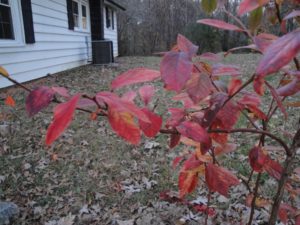
Blueberry ‘Patriot’ in fall color.
If uniform little muffins are what you want, look for dwarf cultivars. Still, avoid shearing them, which removes many flowers and potential fruits. Some suggestions for dwarf blueberries include ‘Top Hat’ (18″ tall, zones 3-7), ‘Ruby Carpet’ (to 2′, zones 3-7), ‘Northsky’ (18″, zones 3-7), ‘Northblue’ (to 3′, zones 3-7), and ‘Sunshine Blue’ (to 3′, zones 5-10, tolerates pH up to 6.0). ‘Sunshine Blue’ has beautiful blue-green foliage, and most blueberries have some red or burgundy fall color.
Blueberry Pollination
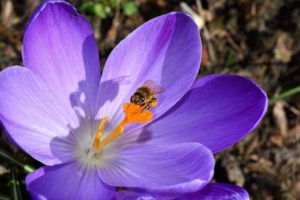
Honey bee attracted to early blooming crocus.
Include in your landscape some early flowering annuals, perennials, bulbs (daffodils, grape hyacinth, crocus) and trees to keep the bees interested.
Every fall and winter, the vegetable garden provides many kinds of greens for the kitchen. When the brassicas flower in late winter and spring (photo, right), I’m in no rush to remove them. They bloom at the same time that blueberries do, attracting bees. The hungry bees and other beneficial insects that collect or feed on the pollen and nectar will return time and time again.
When blueberry bushes are in flower on a mild spring day, you’ll be able to hear the bees busily working. Honey bees and wild bees pollinate blueberries, but bumble bees are by far the most efficient at pollinating the flowers.
The county extension service can recommend blueberry varieties for your area. Plant a few cultivars from within a group (for example, rabbiteye or southern highbush). One cultivar (“cultivated variety”) might bloom early in the season, and another in the same group might flower weeks later, missing an opportunity for pollination. By having several varieties from the same group in the garden, their blooming periods will overlap, ensuring thorough pollination. This results in larger fruits and a continuous harvest.
Disease
Thinning old plants lets air circulate freely among the branches and helps prevent diseases from spreading. If you see black spots on the leaves, dead stems, moldy flowers, or rust-colored patches on the reverse, consult your garden center experts or the county agricultural extension service for advice.
There are many diseases that can affect crops in our back yards or in blueberry fields. Enclose samples in plastic bags and take them to your local agricultural extension office for diagnosis.
For starters, though, don’t plant near hemlocks, space plants generously, avoid drought stress, keep the foliage dry, get the drainage right, and inspect your plants. Dip pruners in a bleach solution before pruning the next plant.
Picking
Pruning is an art. And it’s a science. No matter what you do to a blueberry plant, though, you’ll most likely be able to pick a few pints of berries. But a healthy, mature plant can yield as much as 10-20 pounds of fruit!
Once the first fruits turn blue, let them stay on the plant for a few more days. They’ll be sweeter if you can resist picking them right away. Gently hold the fruit cluster in your hand; the ripe ones will easily fall off with a slight touch.
Five years before I moved to North Carolina, I potted up two blueberry plants with the intention of taking them with me. They could have grown quite large, but they were more easily managed if I pruned the oldest canes every year. Except for the year the woodchuck paid a visit, we were picking fruit from them for more than 2 months…easily 10 pounds per plant!
I wish I could tell you the names of the varieties, but…I forgot to take the pots with me…when I moved…
Woodchuck and Friends
That woodchuck I referred to was one fat and happy animal. One year, he ate every single blueberry on those two plants—blue, green, and all shades in between! After that happened, I moved the plants into the unheated greenhouse after they had been pollinated. Bees came in through the vents to continue pollinating as new flowers opened. But the birds and the woodchucks were banned.
Deer, bears, and other mammals all enjoy feasting on your blueberries. And birds, of course. For a worry-free harvest, protect the plants from marauding thieves before you regret not having done it.
Plant Protection
For a few plants, use tall stakes securely anchored in the ground as a frame to support bird netting. After the harvest season, remove the protection. Use generous dimensions so the stems don’t become entangled in the netting. Cover every square inch, making sure there are no gaps that a bird could squeeze through. Once a bird gets in and can’t find its way out, it will die.
Figure out an easy way to access the fruits, which you might be picking every day while they’re in season.
- Non-venomous rat snake caught in bird netting.
- 15 minutes later, one happy snake!
If you use netting anywhere in the garden, check it daily. Sometimes a snake will get caught in it, especially if you live near woods. I used sharp-nosed scissors to cut the netting away from this non-venomous rat snake, starting at the tail-end.
He didn’t fuss at all as I carefully snipped him free. Be sure to remove loops that have become embedded in the scales; they will kill him, and no one wants that. Incidentally, snakes prefer rodents, not blueberries. Call Animal Control or the Fish and Wildlife Service if it’s something you don’t want to handle, or if you’re unsure whether it might be venomous. But don’t let the poor thing suffer.
If you have many blueberry plants in your garden and don’t mind sharing with birds and other wildlife, don’t bother covering them. Some gardeners plant blueberries specifically for the birds.
Cage Your Blueberry Plants
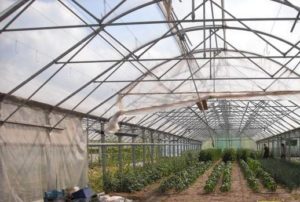
But, if you want to claim most of the harvest for yourself and your family, consider building a structure that will allow the bees to get in but will exclude everyone else. Several of my customers over the years have done just that, and none have regretted it.
Construct a frame, using PVC tubing, and cover it with bird netting or the more durable hardware cloth. Make sure the holes are large enough for honey bees and bumble bees to pass through, but small enough to exclude birds. Include a door, a potting bench, and somewhere to put the coffee mug, and you’re set. As one gentleman told me, “It’s bliss.”
Frames for greenhouses or high tunnels made from cattle panels are two suggestions. I’ve seen old dog kennels converted into growing spaces (over clean soil, I hope) by covering with bird netting. Add your summer vegetables for an animal-free zone.
***Update***: Now that I’ve lived at this rural property in North Carolina for about 1½ years, I’ve decided to build a structure that will house the berries and the small fig tree. I’ll use 4×4″ posts, wire fencing and insect screening to keep all critters away. An important exception is to allow bees in for pollination. Strawberries will grow in raised beds with copper tape to repel slugs. By early summer, Japanese beetles begin ravaging blueberry leaves, but that’s after most of the berries have been harvested. The word is out among the local deer, birds, raccoons, and groundhogs that Kim’s Restaurant is open 24/7. That policy is about to change. June 2023
Practicalities
Take into consideration freezing rain, hail, strong winds, and snow load that could collapse the structure. Think of these disasters before they happen. Consult a contractor or check videos online for basic construction details that suit your area. Some gardeners prefer to keep their blueberries uncovered most of the year, when they’re not fruiting.
Always contact municipal authorities before building a structure or digging anywhere. Some structures require a building permit. Have underground utilities marked by the local “before you dig” (8-1-1) authorities.
Mmmm…blueberry muffins! Sure, we’ll miss out on the full complement of antioxidants now and then (if the recipe also contains dairy products). I’ll just eat an extra handful later.
To better health, one berry at a time!
Could planting a blueberry garden be the way you celebrate National Blueberry Month?
Headings
Page 1: Planting a Blueberry Patch?, Today Is Day One, What Antioxidants Do (Blueberry Nutrients, More Benefits), Prepare for Planting Your Blueberry (Sun, Drainage, Gypsum, Soil PH), Time To Plant Your Blueberry (Grab Your Shovel, First Pruning, Label the Blueberry, Mulch, Water, How Are They Looking?, Settled In), Family Likeness
Page 2: The 5 Major Groups of Blueberries (Lowbush Blueberry, Northern Highbush Blueberry, Southern Highbush Blueberry, Rabbiteye Blueberry, Half-High Blueberry), Blueberry Maintenance (Water, Mulch, Fertilizer, Pruning, Blueberry Pollination, Disease, Picking), Woodchucks and Friends, Plant Protection, Cage Your Blueberries
